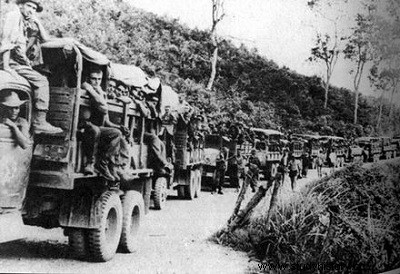
January 1949, Mao Tse Tung returned to Beijing. At the beginning of March, the Chinese communist gangs began to operate in liaison with the Vietminh. On the night of March 16 to 17, 1949, 1,500 Viet Minh men, supported by significant Chinese reinforcements, seized two posts between Na Chan and That Khé. On the 25th, elements of the People's Liberation Army, coming from Kouang Toung, narrowly failed to seize Moncay.
This time, it is the delta itself and Hanoi that are under threat.
In Paris, as in Hanoi, headquarters of the High Command of the Expeditionary Force, two strategies clash :should we abandon the Upper Region, deemed indefensible, to better hold the Delta (Revers plan) or strengthen our presence all along the border to prevent a total osmosis between Vietnamese and Chinese communists, which condemns us in the long term. The debate lasted more than a year.
The second capture of Dong Khé, on September 17, 1950, by Giap's troops after extremely violent fighting settled the debate:this is what awaits the
French posts. Including Cao Bang, who, with his 600 legionnaires of the 3' battalion of the 3' R.E.I. (Commander Forget), its 600 goumiers of 3’ Tabor arrived as reinforcements by plane, its 1,000 partisans, its 500 mountaineers, its citadel and its artillery, remains the most formidable fortress in Indochina.
But, isolated between its rocky peaks, how long would it resist the formidable Viet regiments of Giap, now equipped with artillery and little accountable for their dead?
At the end of September, the Evacuation decision is made. On the 30th, the order arrived at the office of Lieutenant-Colonel Charton, who commanded the Cao Bang garrison.
The evacuation order specified that the Charton group would be picked up and helped 22 km away. south of Cao Bang by another group, baptized “Bayard” and commanded by Colonel Lepage, an artilleryman (promotion of “Souvenir”, 1921-1923). This joining of the two forces - 5,000 soldiers in total - responds to a concern that Colonel Charton himself expressed to General Allessandri, commander of the Land Forces of Northern Indochina - and opponent of the evacuation:“I know the R.C.4 for having done it more than twenty times, Charton had said. relief column at least at km 22 south of Cao Bang. If someone comes to wait for me at km 18, there will be no more difficulty. »
Since September 19, the Lepage group has been in That Khé, busy with routine missions. General Carpentier, who commands in Hanoi, only asked Colonel Lepage to be ready to act as part of an overall operation. Which ? Lepage ignores it.
On September 30, he finally received specific orders. The "Bayard" group is formed:it includes the 1st foreign parachute battalion (B.E.P.) of Commander Segrétain, dropped on That Khé on September 17 and 18, the marching battalion of the 8th R.T.M. (Commander Arnaud), the 1st and 11' Tabor (Captain Feugeas, Commander Delcros), a protective goum and 50 partisans. Mission:retake Dong Khé before noon on October 2. What purpose ? Lepage still doesn't know.
The elements of the tragedy are in place.
In addition to its soldiers, Cao Bang, in the last hours of the French presence, in September 1950, it is also 3,000 civilians, Tho, Chinese, Vietnamese, Nungs, Meos, including the families of partisans. “The native population, writes Charton, was entirely won over to the Franco-Indochinese cause. The civil governor, Mr. Thu, although he was not a supporter of Emperor Bao Dai as Tho, was very sure. He had to pay with his life for his loyalty to France. The Legion of Honor has just been awarded to the civil governor. Poisoned gift.
Many refugees from former evacuated posts (Tra Linh, Nguyen Binh, Ban Cao, etc.) further burdened this local population.
